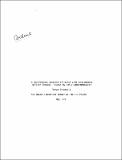| dc.description.abstract | A significant mismatch may exist between residential load
characteristics and array output from photovoltaic energy conversion
systems. This has warranted a closer look at incorporating energy storage
as a supplement device. Storage enhances total system energy capture
although its weighted benefit is highly sensitive to the particular
operating scheme. For utility interfaced systems which include a schedule
for utility purchase of excess PV output, the advantage of the additional
capture becomes a fairly complex function of the rated price structure,
utility buy-back, and the system control logic. The problem arises since
photovoltaics and storage each stand as independent investment
opportunities for grid interconnected users, thus offering the potential
for competition between them. This competition is characterized by a total
system value somewhere below their additive stand-alone values.
This study includes a search for a system control logic, along with the
economic and location-specific conditions, which maximize total system (PV
and storage) value. The latter is defined in terms of the breakeven
capital costs at which a user-owner would be economically indifferent
toward purchase, given the utility as the sole competitor. Numerous
customer-utility relationships are possible in addition to a variety of
system configurations. Here, a utility interfaced storage operation
without photovoltaics is examined against a tandem (PV-battery) arrangement
with a range of utility buy-back policies. No studies were made to assess
the value of only photovoltaics or only storage to the utility, though
analysis on photovoltaics can be found in both Tatum (8) and Carpenter and
Taylor (3).
The residence hardware and behavioral simulation were accomplished with
the use of models previously developed by members of the MIT Energy
Laboratory. | en |
